- Home
- Editor's Notes
- Current Issue
- Riki Reflects
- Spiritual Traveler
- Starz Emporium
- Classifieds
- Advertise with Us
- Submissions
- Awards
- About Us
- Contact Us
The Mysticism of William Blake: Visionary Art and Sacred Imagination
By Stephen William
.jpg) The Mysticism of William Blake: Visionary Art and Sacred Imagination
An Inquiry into the Divine Realms of a Poetic Prophet By Stephen William, author of: ”Nostradamus His Prophecy Finally Explained.” Available on Amazon Kindle now. https://www.amazon.co.uk/dp/B098LS5PM7/ref=cm_sw_em_r_mt_dp_MBDF06G549ZKJ6XFKMCJ Few figures in literary and artistic history radiate with as much enigmatic brilliance as William Blake. A painter, engraver, and poet, Blake’s life was a testament to the power of vision, imagination, and the relentless pursuit of creative and spiritual truth. Dismissed in his own time as eccentric or even mad, Blake’s influence has only grown, his work now recognised as foundational in both the Romantic movement and the development of modern visionary art. William Blake stands apart in the English- speaking world literary and artistic tradition as an enigmatic figure whose work is suffused with mysticism. To encounter Blake is to enter a world where the lines between the material and the spiritual are blurred, where angels converse with mortals, and where the imagination reigns as the gateway to the infinite. 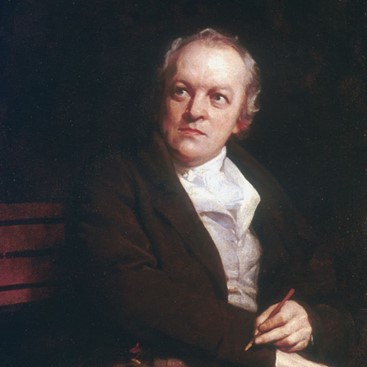 PORTRAIT OF WILLIAM BLAKE BY THOMAS PHILLIPS. William Blake was born on 28 November 1757 at 28 Broadwick Street, in the Soho district of London. The son of a hosier, James Blake, and his wife Catherine, young William grew up in a bustling, at times grimy, metropolis at the heart of the world’s then greatest empire. His family was neither poor nor wealthy, but they valued education and encouraged Blake’s early artistic inclinations. His family was also very religious and belonged to The English Dissenters, a radical Protestant group who had split from the main Protestant Church of Englan From an early age, Blake was different, given to visions and mystical experiences. He later recounted that, aged four, he saw the face of God at a window, and at eight, he saw “a tree filled with angels, bright angelic wings bespangling every bough like stars.” These visionary episodes were neither fleeting nor isolated but became a thread running through the tapestry of his life. 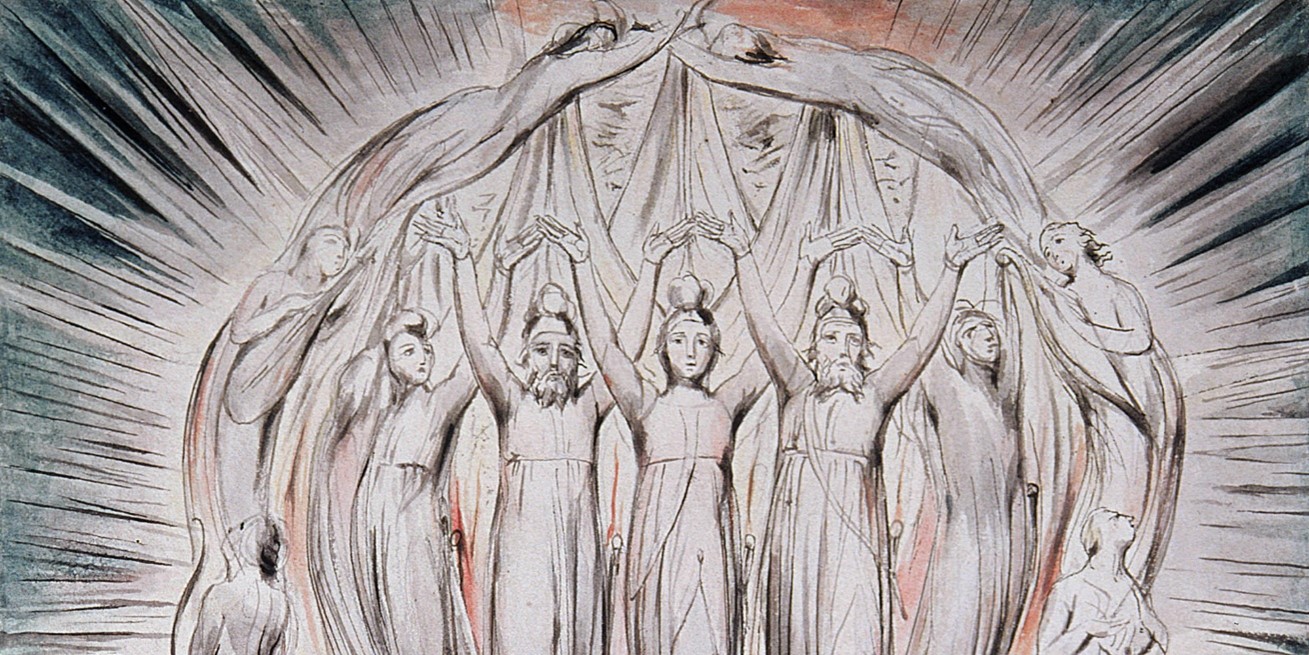 ANGELS DRAWN BY WILLIAM BLAKE. ANGELS APPEARED FREQUENTLY IN HIS ART. Blake’s formal education was limited. He attended drawing school as a child and, at age 14, began a seven-year apprenticeship with the engraver James Basire. This training would prove pivotal. It equipped Blake with the craftsmanship to pursue a career as both artist and printer and exposed him to the art and architecture of the Gothic tradition, which would inform his developing abilities. After completing his apprenticeship, Blake briefly attended the Royal Academy of Arts, where he encountered the tension between his own idiosyncratic vision and the classical ideals promoted by figures such as Sir Joshua Reynolds. Blake’s distaste for academic art doctrine and tradition would define his career. He remained outside the mainstream, preferring the wild landscapes of the imagination to the cultivated conventions of polite society. His spiritual inspiration and creativity was not to be restrained by hidebound ideas. In 1782, Blake married Catherine Boucher, an illiterate woman(which was common amongst the lower classes in those days) whom he taught to read, write, and assist in his artistic work. Their marriage, by all accounts, was one of deep affection and partnership. Together, they endured both financial hardship at times and great creative adventure. Blake’s early career was divided between commercial engraving and his own poetic and artistic experiments. His first volume of poems, “Poetical Sketches,” was published in 1783. While the book received little attention, it contained the seeds of the visionary voice that would later blossom in his mature work. Blake’s true genius lay in his ability to fuse poetry and visual art. Between 1789 and 1794, he produced a series of works now known as the “Illuminated Books,” where he wrote, illustrated, engraved, and hand-coloured each page. These included “Songs of Innocence” (1789), “Songs of Experience” (1794), “The Book of Thel,” and “The Marriage of Heaven and Hell.” His then unique process—relief etching—allowed for an intimate, handcrafted marriage of verse and image, utterly unlike anything else in the literature or art of his time. It had a 3D quality in printing that was revolutionary for its time. 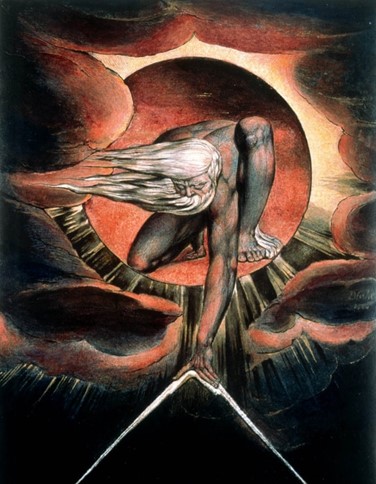 BLAKE’S DEPICTION OF A JUDGEMENTAL GOD . BLAKE’S OWN IDEA OF GOD WAS OF A MORE LOVING AND SUPPORTIVE GOD. THIS IMAGE WAS PRODUCED BY USING HIS RELIEF ETCHING PROCESS. “Songs of Innocence and of Experience” remains Blake’s most beloved work, presenting paired poems that reveal the contrary states of the human soul. “The Tyger” and “The Lamb,” two of English poetry’s most famous animals, exemplify his gifts—their language simple, their meanings profound, their visual presentation haunting. Blake’s visual style was equally distinctive: ethereal figures, swirling lines, and luminous colours created otherworldly scenes, populated by angels, prophets, and mythic beings. His art was deeply symbolic, often drawing on his personal mythology—a complex universe inhabited by characters such as Urizen, Los, and Albion. Prophet in an Age of Revolution.Blake lived through the convulsions of the American and French Revolutions and the beginnings of the Industrial Revolution, events that transformed the world and inspired both hope and terror. His works bristle with radical energy. In “The Marriage of Heaven and Hell,” for instance, he declares: “If the doors of perception were cleansed, everything would appear to man as it is, infinite.” Blake’s vision was one of liberation, from tyranny, from convention, from the chains of reason alone. His mystic view of existence of obviously was generated by his spiritual visions.Blake was a political and spiritual radical. He opposed the slave trade and championed the poor. His poetry often inveighed against the “dark Satanic mills” of industrial England and the cruelties of “institutional religion” which put profit and oppression before morality. Yet, his radicalism was always laced with a deep, personal spirituality. Blake’s God was not an angry lawgiver but a living force of imagination and mercy. 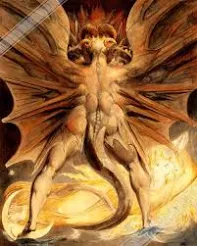 BLAKE’S IMAGE OF A DRAGON. NOTICE THE HUMAN LIKE LEGS AND BODY. BLAKE WAS PROBABLY DEMONSTRATING THAT BAD ACTIONS COME FROM A PERSON’S OWN WEAKNESSES RATHER THAN SOME EXTERNAL EVIL SPIRITUAL SOURCE. . 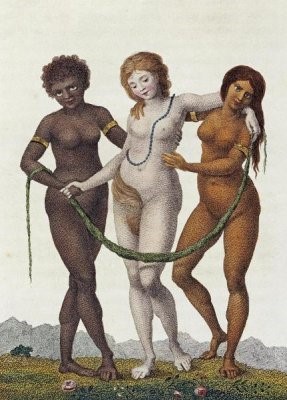 “EUROPE SUPPPORTED BY AFRICA AND AMERICA”. BLAKES PICTURE DEPICTS THE CONTINENTS AS FEMALE FIGURES . BLAKE THE SLAVERY ABOLITIONIST AND ANTI-IMPERIALIST DEPICTS THE ENSLAVED CONTINENTS BY GOLD ARM BANDS ON THE ARMS ON OF AFRICA AND AMERICA. EUROPE IS PHYSICALLY SUPPORTED BY THEM BOTH. HOWEVER, IT PERHAPS ALSO SUGGESTS FUTURE FRIENDLY COOPERATION BY ALL PEOPLE OF THE WORLD. 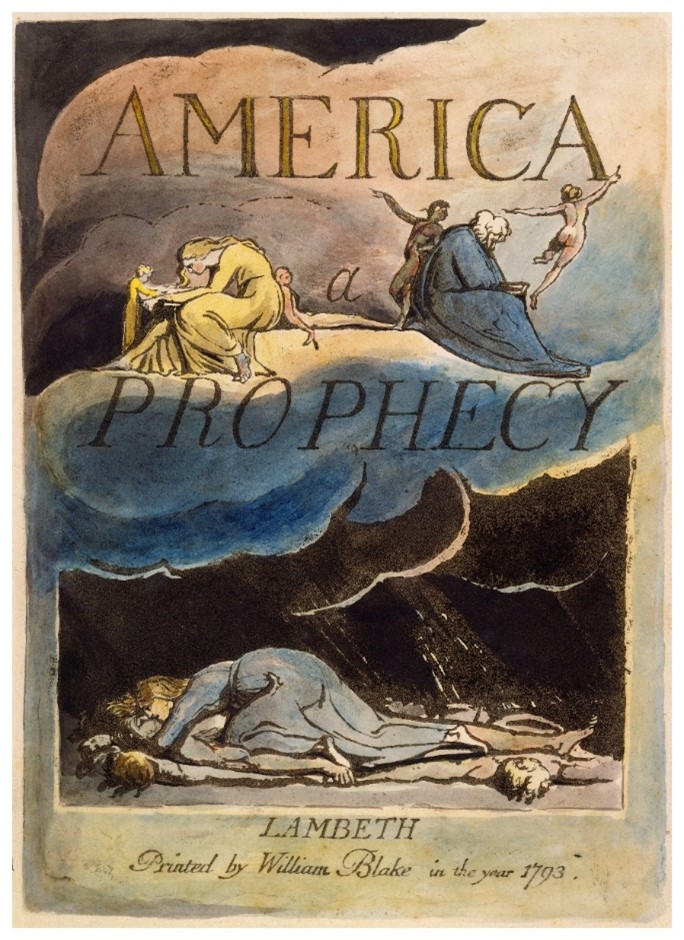 BLAKE SUPPORTED BOTH THE AMERICAN AND FRENCH REVOLUTIONS AS HE BELIEVED MONARCHIES ABUSED THEIR POSITIONS AND POWERS. IN1793 HE PRODUCED THIS BOOK CALLED “AMERICA A PROPHECY”. THE ”PREDICTIONS” WERE BASED MAINLY AROUND FICTIONAL CREATIONS OF HIS IMAGINATION.HOWEVER, HE DID FORESEE THE SURVIVAL OF THE NEW NATION WHICH MAY HAVE SPLIT APART(AS IT DID DURING THE AMERICAN CIVIL WAR) OR BE REINVADED BY THE BRITISH( AS WHEN THE BRITISH ATTACKED AND BURNT WASHINGTON DURING THE WAR OF 1812). THERE WAS ALSO THE POSSIBILTY THAT THE SPANISH AROUND 1793 COULD HAVE TRIED TO EXPAND THEIR EMPIRE FROM THEIR NORTH AMERICAN POSSESSIONS (ARIZONA, CALIFORNIA, FLORIDA ETC) INTO THE NEW UNITED STATES. BLAKE SAW BEYOND THIS AND SAW THE FLEDGING UNITED STATES AS NEW FORM OF COUNTRY THAT WOULD SURVIVE INTO THE FUTURE.. Despite his genius, Blake’s life was marked by poverty and obscurity. He struggled to find patrons, and his unconventional style bewildered the public and critics alike. He was arrested for sedition in 1803 (and later acquitted) for attacking a uniformed British soldier as a demonstration of his stand against imperialism and war .He and Catherine spent his final years in relative seclusion, producing illustrations for works such as the “Book of Job” and Dante’s “Divine Comedy.” Yet Blake never lost faith in his art or his visions. In his last years, he gathered around him a small circle of young artists known as “The Ancients,” who revered him as a prophet. He died on 12 August 1827, singing hymns and working to the very end. He was buried in an unmarked grave in Bunhill Fields, London, a visionary to the last. So was he a true mystic? A man with the supernatural ability to connect with spiritual realm ? I believe he was . The sheer dedication to his controversial work with its prophetic and very modern and mystical interpretation of religious matters, he appears to be in the same mould as Old Testament figures such as Samuel, Elijah, Amos etc. They were all totally radical in their outlook compared to prevailing spiritual practices of their times and challenged the authority figures of their times also. Blake to me appears to be a bridge between old style conventional religion and what was to become modern mysticism. He used what appeared to be traditional and legendary themes and fused them with his own direct spiritual experiences, therefore involving the reader or picture viewer in his own personal experiences. Blake’s work remained obscure for decades after his death, but the late Victorians (1870s onwards) began to rediscover his poetry, and the Pre-Raphaelite painters found inspiration in his art. In the twentieth century, Blake’s reputation soared! He was hailed as a forerunner of Romanticism, a precursor to surrealism and abstract art. He was seen as a prophet for every generation that has questioned authority and sought new ways of seeing. Here is Blake’s most famous poem, “Jerusalem”. It is based on the non-Biblical legend of Joseph of Arimathea ,who was supposed to be Jesus’s great uncle in the legend, bringing the teenaged Jesus to Glastonbury in England on one of his trading trips. Although traders from the Middle East were supposed to have visited first century Britain to buy tin and copper etc., it is 99% unlikely that Joseph was one of them. William Blake demonstrates his skepticism of this but turns it into a call for practical spirituality in his own time. It is as follows. And did those feet in ancient time Walk upon England's mountains green? And was the holy Lamb of God On England's pleasant pastures seen? And did the Countenance Divine Shine forth upon our clouded hills? And was Jerusalem builded here Among these dark Satanic mills? Bring me my bow of burning gold: Bring me my arrows of desire: Bring me my spear: O clouds unfold! Bring me my chariot of fire. I will not cease from mental fight, Nor shall my sword sleep in my hand Till we have built Jerusalem In England's green and pleasant land. Blake’s mysticism and passion demonstrates that though the legend may not actually be true, by the question marks in the first verse, the sentiment of kindness and righteousness in Jesus’s teachings had been abandoned in the 18th century Britain. It rejects the pursuit of profit and the terrible working conditions of the factories (“Satanic mills”) of the Industrial Revolution. He implies the English should instead build a “New Jerusalem” instead of concentrating on crass materialism. In 1916 , nearly 90 years after Blakes death, the composer Hubert Parry set the words of “Jerusalem” to music thereby turning it into a hymn. As 1916 was the middle of World War One (1914-1918) its beautiful words of hope and building a better world in the future made it instantly popular. It is still popular in England and in some other parts of the Commonwealth today and is often played and sung at weddings and funerals. It was one of the hymns at both my parents funerals. If you wish to hear it ,it is on the Amazon Smart Speaker by the Kings College Choir in many countries or on other streaming services or elsewhere online. Conclusion: The Artist as VisionaryWilliam Blake remains a singular figure,a man out of time yet perfectly attuned to the deepest currents of human experience. He saw angels where others saw only trees and in the harshness of London’s streets, he found the seeds of paradise. In a world grown ever more mechanical and rational. Blake’s life and work stand as a reminder of the power of vision, the necessity of the imagination and the unquenchable human longing for the infinite.Let us remember Blake not just as a poet or painter, but as a visionary—one who saw the world not only as it is, but as it could be, if only we open ourselves to wonder and spiritual search. Please explore his work yourself ,if you can. ©Stephen William International Copyright. My book which covers modern mysticism as well as Nostradamus’s , is available at only US $ 3.45 on Amazon Kindle or FREE TO READ if you are a Kindle Unlimited member. please follow this following link https://www.amazon.co.uk/dp/B098LS5PM7/ref=cm_sw_em_r_mt_dp_MBDF06G549ZKJ6XFKMCJ |
Share this article with friends!
|
Copyright © 1998 - 2025 Mystic Living Today All rights, including copyright, in the content of these Mystic Living Today web pages are owned or controlled for these purposes by Planet Starz, Inc. Terms of Service Disclaimer and Legal Information For questions or comment, contact Starzcast@mysticlivingtoday.com. Reproduction of this page in any form is not allowed without permission of the author and the owner of this site. All material on this web site, including text, photographs, graphics, code and/or software, are protected by international copyright and trademark laws. Unauthorized use is not permitted. You may not modify, copy, reproduce, republish, upload, post, transmit or distribute, in any manner, the material on this web site. Unless permissions is granted. |



